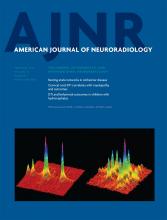Index by author
Grant, P.E.
- Pediatric NeuroimagingYou have accessDiffusion Tensor Analysis of Pediatric Multiple Sclerosis and Clinically Isolated SyndromesM.S. Vishwas, B.C. Healy, R. Pienaar, M.P. Gorman, P.E. Grant and T. ChitnisAmerican Journal of Neuroradiology February 2013, 34 (2) 417-423; DOI: https://doi.org/10.3174/ajnr.A3216
Gray, J.
- Pediatric NeuroimagingYou have accessImaging Changes in Very Young Children with Brain Tumors Treated with Proton Therapy and ChemotherapyN.D. Sabin, T.E. Merchant, J.H. Harreld, Z. Patay, P. Klimo, I. Qaddoumi, G.T. Armstrong, K. Wright, J. Gray, D.J. Indelicato and A. GajjarAmerican Journal of Neuroradiology February 2013, 34 (2) 446-450; DOI: https://doi.org/10.3174/ajnr.A3219
Gruber, H.
- Spine Imaging and Spine Image-Guided InterventionsYou have accessUltrasound Guided Versus CT-Controlled Pararadicular Injections in the Lumbar Spine: A Prospective Randomized Clinical TrialA. Loizides, H. Gruber, S. Peer, K. Galiano, R. Bale and J. ObernauerAmerican Journal of Neuroradiology February 2013, 34 (2) 466-470; DOI: https://doi.org/10.3174/ajnr.A3206
Guerrini, R.
- PediatricsOpen AccessBilateral Posterior Periventricular Nodular Heterotopia: A Recognizable Cortical Malformation with a Spectrum of Associated Brain AbnormalitiesS.A. Mandelstam, R.J. Leventer, A. Sandow, G. McGillivray, M. van Kogelenberg, R. Guerrini, S. Robertson, S.F. Berkovic, G.D. Jackson and I.E. SchefferAmerican Journal of Neuroradiology February 2013, 34 (2) 432-438; DOI: https://doi.org/10.3174/ajnr.A3427
Gupta, V.
- FELLOWS' JOURNAL CLUBSpine Imaging and Spine Image-Guided InterventionsYou have accessCervical Spine MR Imaging Findings of Patients with Hirayama Disease in North America: A Multisite StudyV.T. Lehman, P.H. Luetmer, E.J. Sorenson, R.E. Carter, V. Gupta, G.P. Fletcher, L.S. Hu and A.L. KotsenasAmerican Journal of Neuroradiology February 2013, 34 (2) 451-456; DOI: https://doi.org/10.3174/ajnr.A3277
The authors sought to determine if Hirayama disease in North America has the same imaging findings as it does in Asia. They assessed imaging studies in 21 patients and looked for loss of attachment of posterior dura, lower cord atrophy and high T2 signal, loss of cervical lordosis, and anterior dural shift in flexion. These 4 findings were able to discriminate patients from healthy controls. MR imaging findings in white North American patients with Hirayama disease include loss of attachment on neutral images and forward displacement of the dura with flexion. Findings are often present on neutral MR images and, in the appropriate clinical scenario, should prompt flexion MR imaging to evaluate anterior dural shift.
Haller, S.
- BrainOpen AccessIndividual Classification of Mild Cognitive Impairment Subtypes by Support Vector Machine Analysis of White Matter DTIS. Haller, P. Missonnier, F.R. Herrmann, C. Rodriguez, M.-P. Deiber, D. Nguyen, G. Gold, K.-O. Lovblad and P. GiannakopoulosAmerican Journal of Neuroradiology February 2013, 34 (2) 283-291; DOI: https://doi.org/10.3174/ajnr.A3223
Harreld, J.H.
- Pediatric NeuroimagingYou have accessImaging Changes in Very Young Children with Brain Tumors Treated with Proton Therapy and ChemotherapyN.D. Sabin, T.E. Merchant, J.H. Harreld, Z. Patay, P. Klimo, I. Qaddoumi, G.T. Armstrong, K. Wright, J. Gray, D.J. Indelicato and A. GajjarAmerican Journal of Neuroradiology February 2013, 34 (2) 446-450; DOI: https://doi.org/10.3174/ajnr.A3219
Hart, E.P.
- BrainYou have accessMagnetization Transfer Imaging in Premanifest and Manifest Huntington Disease: A 2-Year Follow-UpS.J.A. van den Bogaard, E.M. Dumas, E.P. Hart, J. Milles, R. Reilmann, J.C. Stout, D. Craufurd, C.R. Gibbard, S.J. Tabrizi, M.A. van Buchem, J. van der Grond and R.A.C. RoosAmerican Journal of Neuroradiology February 2013, 34 (2) 317-322; DOI: https://doi.org/10.3174/ajnr.A3303
Hassan, A.E.
- FELLOWS' JOURNAL CLUBNeurointerventionOpen AccessMicrocatheter to Recanalization (Procedure Time) Predicts Outcomes in Endovascular Treatment in Patients with Acute Ischemic Stroke: When Do We Stop?A.E. Hassan, S.A. Chaudhry, J.T. Miley, R. Khatri, S.A. Hassan, M.F.K. Suri and A.I. QureshiAmerican Journal of Neuroradiology February 2013, 34 (2) 354-359; DOI: https://doi.org/10.3174/ajnr.A3202
This study addresses the relationship among procedure time, recanalization, and clinical outcomes in patients with acute ischemic stroke undergoing endovascular treatment. Demographics, NIHSS scores before and 1 day after the procedure, and modified Rankin Scale scores were assessed in 209 patients. Patients with procedure times ≤30 minutes had lower rates of unfavorable outcome at discharge compared with patients with procedure times ≥30 minutes. Rates of favorable outcomes in endovascularly treated patients after 60 minutes were lower than rates observed with placebo treatment. Unfavorable outcome was positively associated with age, admission NIHSS strata, and longer procedure times.
Hassan, S.A.
- FELLOWS' JOURNAL CLUBNeurointerventionOpen AccessMicrocatheter to Recanalization (Procedure Time) Predicts Outcomes in Endovascular Treatment in Patients with Acute Ischemic Stroke: When Do We Stop?A.E. Hassan, S.A. Chaudhry, J.T. Miley, R. Khatri, S.A. Hassan, M.F.K. Suri and A.I. QureshiAmerican Journal of Neuroradiology February 2013, 34 (2) 354-359; DOI: https://doi.org/10.3174/ajnr.A3202
This study addresses the relationship among procedure time, recanalization, and clinical outcomes in patients with acute ischemic stroke undergoing endovascular treatment. Demographics, NIHSS scores before and 1 day after the procedure, and modified Rankin Scale scores were assessed in 209 patients. Patients with procedure times ≤30 minutes had lower rates of unfavorable outcome at discharge compared with patients with procedure times ≥30 minutes. Rates of favorable outcomes in endovascularly treated patients after 60 minutes were lower than rates observed with placebo treatment. Unfavorable outcome was positively associated with age, admission NIHSS strata, and longer procedure times.








